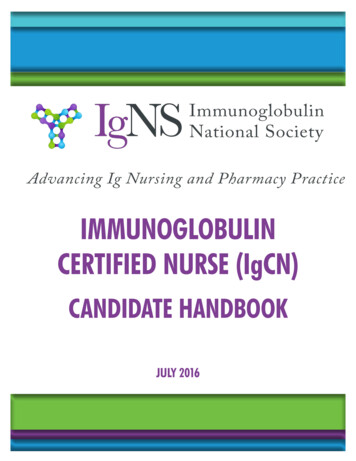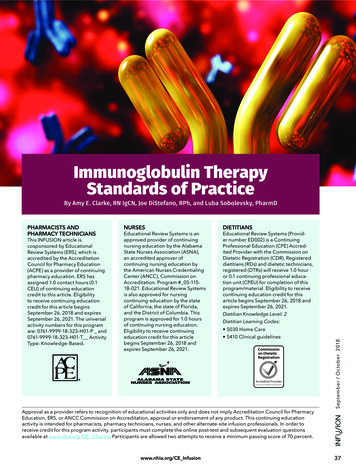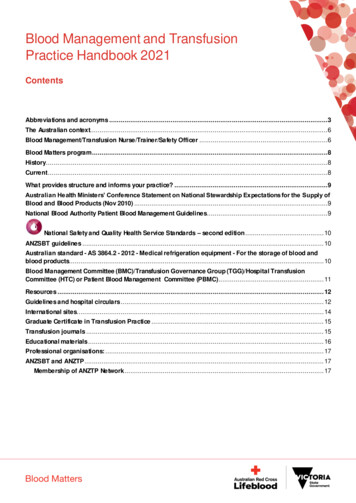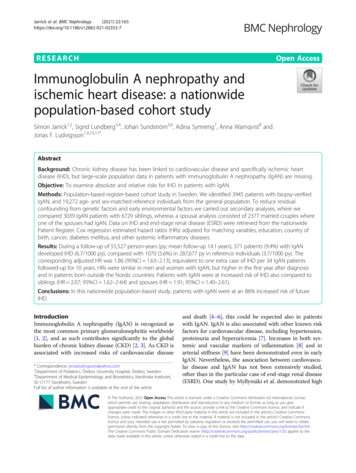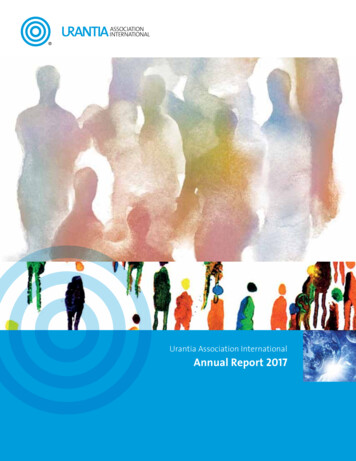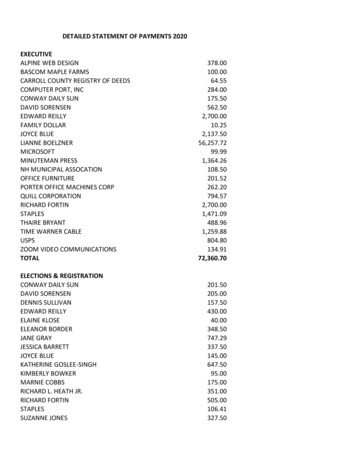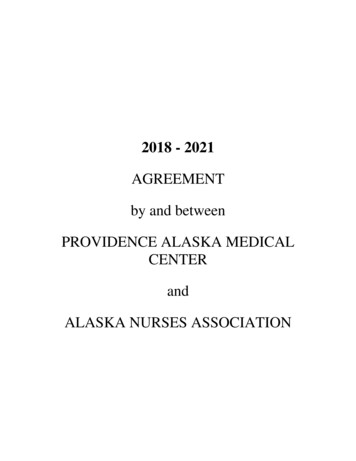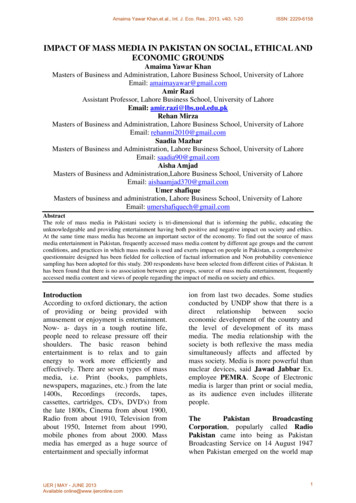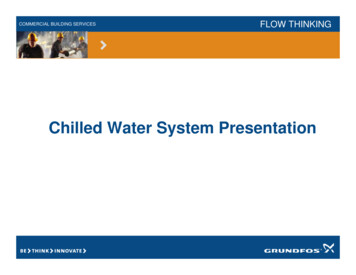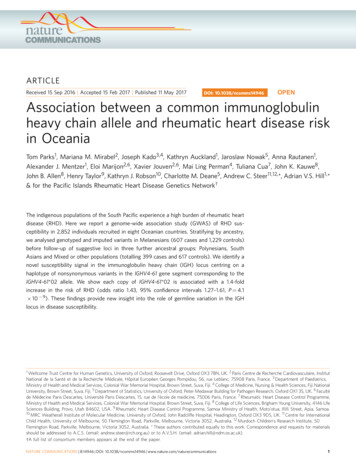
Transcription
ARTICLEReceived 15 Sep 2016 Accepted 15 Feb 2017 Published 11 May 2017DOI: 10.1038/ncomms14946OPENAssociation between a common immunoglobulinheavy chain allele and rheumatic heart disease riskin OceaniaTom Parks1, Mariana M. Mirabel2, Joseph Kado3,4, Kathryn Auckland1, Jaroslaw Nowak5, Anna Rautanen1,Alexander J. Mentzer1, Eloi Marijon2,6, Xavier Jouven2,6, Mai Ling Perman4, Tuliana Cua7, John K. Kauwe8,John B. Allen8, Henry Taylor9, Kathryn J. Robson10, Charlotte M. Deane5, Andrew C. Steer11,12,*, Adrian V.S. Hill1,*& for the Pacific Islands Rheumatic Heart Disease Genetics NetworkwThe indigenous populations of the South Pacific experience a high burden of rheumatic heartdisease (RHD). Here we report a genome-wide association study (GWAS) of RHD susceptibility in 2,852 individuals recruited in eight Oceanian countries. Stratifying by ancestry,we analysed genotyped and imputed variants in Melanesians (607 cases and 1,229 controls)before follow-up of suggestive loci in three further ancestral groups: Polynesians, SouthAsians and Mixed or other populations (totalling 399 cases and 617 controls). We identify anovel susceptibility signal in the immunoglobulin heavy chain (IGH) locus centring on ahaplotype of nonsynonymous variants in the IGHV4-61 gene segment corresponding to theIGHV4-61*02 allele. We show each copy of IGHV4-61*02 is associated with a 1.4-foldincrease in the risk of RHD (odds ratio 1.43, 95% confidence intervals 1.27–1.61, P ¼ 4.1 10 9). These findings provide new insight into the role of germline variation in the IGHlocus in disease susceptibility.1 WellcomeTrust Centre for Human Genetics, University of Oxford, Roosevelt Drive, Oxford OX3 7BN, UK. 2 Paris Centre de Recherche Cardiovasculaire, InstitutNational de la Santé et de la Recherche Médicale, Hôpital Européen Georges Pompidou, 56, rue Leblanc, 75908 Paris, France. 3 Department of Paediatrics,Ministry of Health and Medical Services, Colonial War Memorial Hospital, Brown Street, Suva, Fiji. 4 College of Medicine, Nursing & Health Sciences, Fiji NationalUniversity, Brown Street, Suva, Fiji. 5 Department of Statistics, University of Oxford, Peter Medawar Building for Pathogen Research, Oxford OX1 3S, UK. 6 Facultéde Médecine Paris Descartes, Université Paris Descartes, 15, rue de l’école de medicine, 75006 Paris, France. 7 Rheumatic Heart Disease Control Programme,Ministry of Health and Medical Services, Colonial War Memorial Hospital, Brown Street, Suva, Fiji. 8 College of Life Sciences, Brigham Young University, 4146 LifeSciences Building, Provo, Utah 84602, USA. 9 Rheumatic Heart Disease Control Programme, Samoa Ministry of Health, Moto’otua, Ifiifi Street, Apia, Samoa.10 MRC Weatherall Institute of Molecular Medicine, University of Oxford, John Radcliffe Hospital, Headington, Oxford OX3 9DS, UK. 11 Centre for InternationalChild Health, University of Melbourne, 50 Flemington Road, Parkville, Melbourne, Victoria 3052, Australia. 12 Murdoch Children’s Research Institute, 50Flemington Road, Parkville, Melbourne, Victoria 3052, Australia. * These authors contributed equally to this work. Correspondence and requests for materialsshould be addressed to A.C.S. (email: andrew.steer@rch.org.au) or to A.V.S.H. (email: adrian.hill@ndm.ox.ac.uk).wA full list of consortium members appears at the end of the paper.NATURE COMMUNICATIONS 8:14946 DOI: 10.1038/ncomms14946 www.nature.com/naturecommunications1
ARTICLENATURE COMMUNICATIONS DOI: 10.1038/ncomms14946Rheumatic heart disease (RHD) is the chronic consequenceof an aberrant immune response to Streptococcus pyogenes(also termed group A streptococcus (GAS)), a processthat leads to scarring and dysfunction of heart valves. Previously,a major public health concern in Europe and the United States,the disease remains a prominent cause of death, heart failure andstroke among young and middle-aged adults in developingcountries1. Although reliable data remain scarce, it is likely thedisease affects at least 16 million individuals worldwide, causingan estimated 300,000 premature deaths each year2; however,relative to its global impact, RHD has been largely neglected byresearchers and funders alike3. Consequently, there has beenlimited progress towards understanding pathogenesis that hashampered efforts in disease control and development of noveltherapies and an effective vaccine4.Host genetic susceptibility is one compelling feature of thedisease that awaits rigorous investigation. For over a century,clinicians have noted the strong familial propensity of acuterheumatic fever (ARF)5, and it was recently estimated on the basisof twin studies dating back to the 1930s that monozygotic twinshave sixfold greater concordance than dizygotic twins6.Moreover, even in highly endemic settings where childhoodGAS infections are ubiquitous, only a minority of the populationdevelop ARF or RHD during their lifetime (up to 5–6%), and thismay indicate that the disease develops only in those who aregenetically predisposed7. Despite this, efforts to delineate hostgenetic susceptibility have so far been limited to a number ofsmall candidate gene studies—many focused on the HLA locus—the results of which have been inconsistent and largelyinconclusive8.Here we report a genome-wide association study (GWAS) ofRHD susceptibility in the endemic settings of Oceania, wherethe disease remains a leading cause of premature deathand disability9. We identify a novel susceptibility signal inthe immunoglobulin heavy chain (IGH) locus centring ona haplotype of nonsynonymous variants in the IGHV4-61 genesegment corresponding to the IGHV4-61*02 allele. Set inpopulations hitherto largely overlooked by genetics research, tothe best of our knowledge, our study is the first GWAS of RHD,providing much needed insight into the pathogenesis of thisdevastating disease. Additionally, as the only study from theGWAS era that we are aware of linking germline coding variantsin the IGH locus to disease susceptibility, our study suggestsfurther consideration should be given to the role of IGHpolymorphism in autoimmune disease.ResultsGenome-wide association analysis. Our study was undertakenusing a collection of 3,412 DNA samples from individualsrecruited in eight Oceanian countries established by the PacificIslands RHD Genetics Network (Fig. 1a). For this analysis wesuccessfully genotyped 3,234 individuals at 239,990 variants usingthe Illumina HumanCore platform (Supplementary Fig. 1b,c). Tosupplement the genotype data, we imputed genotypes of variantsfalling between those assayed directly. However, owing to theabsence of Oceanian populations from current reference panels,we undertook low-coverage whole-genome sequencing of 64Melanesian individuals recruited in New Caledonia (Supplementary Fig. 2a–c). As suggested previously10, we phased 9,489,051variants identified through sequencing (13.0% of which werenovel) onto a haplotype scaffold of 622,740 variants, ascertainedby genotyping the same individuals and a further 64 individualsrecruited in Fiji using the Illumina HumanOmniExpressExomeplatform, a higher density array. We then performed genomewide imputation using the phased Oceanian sequenced data2(128 haplotypes) integrated with the phase 3 release from the1000 Genomes Consortium (5,008 haplotypes). Testing the utilityof the integrated panel, we found the mean sample concordance,a standard measure of imputation accuracy, improved by 4–5% inindividuals of Oceanian ancestry as compared with imputationusing the 1000 Genomes reference panel alone (SupplementaryFig. 2d).The samples available to us were of diverse genetic ancestryreflecting not only their varied provenance but also underlyingstructure and admixture (Fig. 1). We chose first to focus onidentifying susceptibility variants with consistent direction andmagnitude of effects across the data set, not least because suchtrans-ancestral analysis can help fine-map causal variation11. Wetherefore used principal components analysis to assignindividuals to one of four ancestral strata: Melanesian;Polynesian; Fijian Indian, that is, South Asian; Mixed or other(Supplementary Fig. 3a–d). Then, after pruning first- and seconddegree relatedness, we performed case–control association testswithin each strata, using linear mixed models (LMM) tominimize residual confounding due to residual structure(Supplementary Fig. 3e) and more distant relatedness(Supplementary Fig. 4b). Having performed a discovery analysisby LMM in the Melanesian strata (l ¼ 1.06; SupplementaryFig. 5a), we combined the resulting association statistics withthose from LMM analyses from the remaining three strata(l ¼ 1.00–1.02; Supplementary Fig. 5b–d) using fixed effects (FE)inversevariance-weightedmeta-analysis(l ¼ 1.05;Supplementary Fig. 5e) that is widely considered the first choicemeta-analysis strategy for variant discovery12.Of the 24 independent signals at suggestive significance in thediscovery analysis (Supplementary Fig. 6), only a signal located inthe IGH locus on chromosome 14 showed evidence of replication(Fig. 2). Comprising 102 variants at genome-wide significance, ofwhich two had been directly genotyped, the signal peaked at asingle nucleotide polymorphism (SNP) located 6 kb upstreamfrom the IGHV4-61 gene segment (rs11846409, FE meta-analysis,P ¼ 3.6 10 9; Supplementary Fig. 7a). This variant wasimputed with certainty 97.5% (information (info.) metric 0.953)and was significantly associated with susceptibility in all fourancestral strata (LMM, P ¼ 1.7 10 5 to P ¼ 0.037). Tofine-map this signal, we performed Bayesian trans-ancestralmeta-analysis using genetic distance between the populations asa prior (Supplementary Fig. 7b)11 and, as previously described,defined a set of 183 credible variants that was 99% likely toinclude the causal variant (Fig. 3a)13. Six of this set wereannotated as coding of which five were located in the second exonof IGHV4-61 (Supplementary Fig. 7c), all part of the previouslydefined IGHV4-61*02 allele14.Confirmation by Sanger sequencing. To resolve the signalfurther, we undertook chain-termination (‘Sanger’) sequencing of a473 base-pair segment of the second exon of IGHV4-61 ina subset of the samples (Supplementary Fig. 8). Among the339 sequenced individuals included in the association analyseswe identified three common haplotypes (Supplementary Fig. 9),two known, matching the IGHV4-61*01 and IGHV4-61*02 alleles,as previously defined, and one novel, comprising a six basein-frame deletion and a nonsynonymous variant that convertsthe amino acid sequence of IGHV4-61 to that of IGHV4-59,provisionally designated IGHV4-61*09 (Supplementary Fig. 10).Although the complexity of the IGH locus makes it difficult to becertain, it seems most likely that this novel allele has been amplifiedfrom the IGHV4-61 locus rather than the IGHV4-59 locus becausethe sequence surrounding IGHV4-61*09 matched the former betterthan the latter (Supplementary Note 1, Supplementary Fig. 11).NATURE COMMUNICATIONS 8:14946 DOI: 10.1038/ncomms14946 www.nature.com/naturecommunications
ARTICLENATURE COMMUNICATIONS DOI: 10.1038/ncomms14946aFrench k Islands49New Caledonia486394b0.03PC 20.02NGHEASEURCSAMELPOLINDMIXCASECONTR0.040.02PC .02–0.010.000.010.020.030.04–0.02–0.01PC 1c0.000.010.020.030.04INDMIXPC igure 1 Oceanian study population. (a) Approximate location where genotyped cases (red) and controls (black) were sampled. (b) Projection of thesamples on to the first and second (left) and first and third (right) principal components (PCs) of genetic variation coloured by self-reported ancestry(MEL, Melanesians; POL, Polynesian; IND, Fijian Indian; MIX, Mixed and other) with cases indicated by empty squares and controls by empty diamonds.Selected samples from the Human Genome Diversity Project Panel (NGH, Papuan; EAS, South East Asian; EUR, European; CSA, Central South Asian) aresuperimposed for comparison and indicated by filled circles. (c) Estimates of admixture proportions from four source populations grouped by self-reportedancestry, with selected samples of Papuan and European ancestry shown at the far left and right, respectively, for comparison.NATURE COMMUNICATIONS 8:14946 DOI: 10.1038/ncomms14946 www.nature.com/naturecommunications3
ARTICLENATURE COMMUNICATIONS DOI: 10.1038/ncomms149468–log10(p)642012345678910 11 12 13 14 15 16 17 18 20 22ChromosomeFigure 2 Genome-wide meta-analysis for RHD susceptibility. For each variant, the negative common logarithm of the P value from an inverse-varianceweighted fixed-effects meta-analysis is plotted against genomic position. The blue horizontal line indicates suggestive significance (FE meta-analysis,P ¼ 10 5) and the red horizontal line indicates genome-wide significance (FE meta-analysis, P ¼ 5 10 8).blog10(Bayes' 1-58107.20IGHV3-64Recombination rate (cM/Mb)acMelansianTyr-58PolynesianTyr-55Fijian IndianVal-30Mixed or osition on chr. 14 (Mb)0.751.01.5Odds ratio2.5Figure 3 Association of the IGHV4-61 locus with RHD susceptibility. (a) For each variant in the 99% credible set, the common logarithm of the Bayes’factor is plotted against genomic position. Variants are coloured by linkage disequilibrium with the most associated variant averaged across the entire dataset (estimated r2: dark blue, 0–0.2; light blue, 0.2–0.4; green, 0.4–0.6; yellow, 0.6–0.8; red, 0.8–1.0). A vertical blue line indicates the position of the fournonsynonymous variants in IGHV4-61 and locations of expressed IGH gene segments are indicated by blue rectangles below the x axis. (b) Forest plot forthe IGHV4-61*02 allele under an additive genetic model with association statistics from LMM analysis in each strata combined by FE meta-analysis.Individual and combined odds ratio estimates with confidence intervals are shown on a logarithmic scale. (c) Structural model of an antibody that includesthe IGHV4-61 heavy variable domain (Protein Databank 4FQQ) showing both heavy (blue) and light (white) chains with both the first (CDR-H1, green) andsecond (CDR-H2, violet) heavy chain complementarity determining loops and the heavy chain interface framework loop (HIFL, red) highlighted. Thepositions that distinguish IGHV4-61*01 from IGHV4-61*02 are shown as spheres labelled with the amino acids found in IGHV4-61*01.When locally imputed into the wider data set, the IGHV4-61*02allele was predicted far more accurately (certainty 97.0%, info.metric 0.935) than its component SNPs had been by genome-wideimputation (certainty 51.4–71.7%, info. metric 0.797–0.877). Usingthe locally imputed data, we found each copy of IGHV4-61*02,which had minor allele frequency 24.9%, was associated with a 1.4fold increased risk of disease (odds ratio 1.43, 95% confidenceintervals 1.27–1.61, FE meta-analysis, P ¼ 4.1 10 9; Table 1).This IGHV4-61*02 signal was very marginally weaker than that forthe lead SNP from the genome-wide analysis (rs11846409, FEmeta-analysis, P ¼ 3.6 10 9), most likely reflecting residualuncertainty surrounding the imputed IGHV4-61*02 genotypes;however, in an analysis limited to the 339 sequenced individualsincluded in the association analyses, the signal for IGHV4-61*02(LMM, P ¼ 0.041) was stronger than that for rs11846409 (LMM,P ¼ 0.062). Across the data set, the IGHV4-61*02 signal showedstrikingly little heterogeneity between the ancestral strata(Cochran’s Q test, P ¼ 0.55; Fig. 3b) and a broadly additive relationship between disease and genotype in each (Supplementary4Fig. 12a–d). Moreover, conditioned on IGHV4-61*02, we foundneither the aforementioned novel deletion haplotype (IGHV461*09, FE meta-analysis, P ¼ 0.50) nor other variants in theIGHV4-61 locus ( 250 kb, FE meta-analysis, minimum P ¼ 0.045)remained associated with disease. Furthermore, the associationbetween IGHV4-61*02 and disease remained statistically significantacross a variety of populations and subpopulations tested as sensitivity analyses (Table 1) including analyses limited to four subsetsof case–control pairs matched by ancestry (FE meta-analysisP ¼ 4.1 10 8; Supplementary Fig. 13a) and the three countries inwhich independent case–control studies had been undertaken (FEmeta-analysis, P ¼ 8.6 10 9; Supplementary Fig. 13b). Finally, ina supplemental analysis involving children recruited in Samoa withmild nondiagnostic valve abnormalities, borderline RHD or definiteRHD, the latter two based on criteria published by the World HeartFederation15, each compared with the Samoan controls used in themain analysis, we found the effect of IGHV4-61*02 stronglycorrelated with diagnostic certainty, there being nil, marginal andsignificant effect, respectively (Supplementary Fig. 13c).NATURE COMMUNICATIONS 8:14946 DOI: 10.1038/ncomms14946 www.nature.com/naturecommunications
ARTICLENATURE COMMUNICATIONS DOI: 10.1038/ncomms14946Table 1 Association of the IGHV4-61*02 allele with RHD susceptibility by ancestry and ySubpopn Subgroup Cases Controls Effective Minor allele freq. MethodNNNCases LRkOR (95% CI)P value1.061.021.011.011.031.091.071.37 (1.19–1.57)1.34 (1.07–1.67)1.49 (1.15–1.94)1.51 (1.15–1.98)1.80 (1.30–2.49)1.77 (1.22–2.58)1.80 (1.21–2.69)1.2 10 .350.210.180.18LMMLMMLMMLR1.020.990.991.041.53 (1.12–2.10)2.07 (1.23–3.50)2.16 (1.25–3.75)2.24 (1.21–4.15)0.00720.00620.00610.0066Fijian 120.11LMMLMMLR111.001.91 (1.18–3.10)1.99 (1.18–3.36)2.02 (1.18–3.49)0.00820.00960.0092Mixed and otherAllAll712362180.260.17LMM1.02 1.54 (0.97–2.46)Fiji IslandsNew .991.39 (1.16–1.67)1.57 (1.25–1.97)2.10 (1.25–3.54)0.0690.000438.6 10 50.0054CI, confidence interval; effective, effective sample size; freq., frequency; LMM, linear mixed model; LR, logistic regression; OR, odds ratio; RHD, rheumatic heart disease; Subpopn, subpopulation.Lines highlighted in bold refer to the initial discovery and replication analyses, while other lines refer to subsequent sensitivity analyses. The genomic control factor (k) was calculated from a genomewide analysis using the analytical method indicated.Structural consequences. We next investigated the structuralconsequences of IGHV4-61*02. Of the five nonsynonymous variants associated with the allele (Fig. 3c), only the proline to alanineat the IMGT (International Immunogenetics Information System)residue 46 is predicted to have a damaging effect on proteinstructure using the Polyphen-2 score (Supplementary Fig. 7c)16.Residue 46 is a component of the heavy chain interface frameworkloop (Fig. 3c) that has an important role in determining theorientation of the heavy chain variable domain relative to lightchain variable domain17, itself a key influence on the bindingproperties of the immunoglobulin molecule17,18. In comparison,there is limited evidence that the other four amino acid changesassociated with IGHV4-61*02 impact on structure or function.Changes to the tyrosine residues at 55 and 58 fall adjacent to andwithin the second heavy chain complementarity determiningregion (CDR-H2) respectively, yet do not appear to alter thestructure as they do not change the canonical class of the loop19,20.These residues may, however, affect binding without changingstructure, particularly because tyrosine residues have highpropensity to be in contact with antigen21 and these positionsoften take part in binding22. The change from valine to isoleucineat residue 30 falls within the first heavy chain complementarydetermining region (CDR-H1), a position known to divide the firstCDR into two loops23, but there are insufficient structural data toestablish the consequences of this change. Finally, the change fromglutamic acid to glutamine at residue 17 is the least likely to affectstructure because of the similar chemical properties of these aminoacids and the fact that residue 17 lies on the surface of the protein,away from the binding site or the variable-heavy to variable-lightdomain interface.DiscussionIn the first GWAS of RHD published to date, we identifieda novel susceptibility signal in the IGH locus. While the relevanceof these results outside Oceania remains to be assessed, theconsistency of the signal across distinct ancestral groups andvarious sensitivity analyses and its correlation with diagnosticcertainty adds weight to our findings.Despite the fundamental role played by antibodies in adaptiveimmunity, germline variation in immunoglobulin genes has seldombeen robustly connected to disease susceptibility24. Humanimmunoglobulin molecules are composed of heavy and lightchains made up of constant and variable domains. DuringB-lymphocyte maturation, the heavy and light chain variabledomains are generated through a process of recombination,junctional diversification and somatic hypermutation of theunderlying gene segments25. The IGH locus is complexconsisting of an estimated 123–129 variable (38–46 annotated asfunctional), 27 diversity (23 functional) and 9 joining (6 functional)gene segments26,27. Extensive structural variation and numerousshort genetic variations introduce considerable diversity with adifferent number of functional variable gene segments present oneach haplotype24. There is also substantial population stratificationand it is highly likely that yet more variability will emerge as furthercomplete haplotypes from diverse global populations aresequenced26. As in the HLA locus, the germline variation in thegene segments has been ordered into alleles, with two or morealleles defined for most of the heavy chain variable genesegments14. Crucially, although examples are scarce, this germlinevariation is thought to be an important determinant of antibodyfunction as well as influencing the naive expressed repertoire24 andconsequently such variation has long been predicted to influencesusceptibility to infectious and autoimmune disease24.In the candidate gene era, germline variation in variable genesegments was linked to susceptibility to a number of autoimmunediseases including multiple sclerosis, rheumatoid arthritis andsystemic lupus erythematous, although the limited reproducibilityof these results cast doubt on the validity of these associations24.Surprisingly, in the GWAS era, only two disease-focusedstudies— investigating Alzheimer’s disease28 and Kawasakidisease29—have reported findings at the IGH locus; however,NATURE COMMUNICATIONS 8:14946 DOI: 10.1038/ncomms14946 www.nature.com/naturecommunications5
ARTICLENATURE COMMUNICATIONS DOI: 10.1038/ncomms14946neither signal reached genome-wide significance nor localized to aspecific gene segment. Indeed, the scarcity of GWAS findings at theIGH locus may be because this locus remains difficult to study. Keychallenges include limited knowledge of IGH polymorphism, poortagging by current standard genotyping arrays and deficiencies inthe publicly available sequence data for this locus, much of whichis derived from transformed B-lymphocytes that have typically lostcomponents of the locus due to recombination24. The limitationsof current genotyping arrays for study of the IGH locus areperhaps best illustrated by the fact that only 16 directly genotypedvariants were included in our imputation scaffold from the entire1,255 kb locus. Thus, although these variants effectively tagged theIGHV4-61*02 signal, it is highly likely that much of the remainingIGH polymorphism was poorly represented in our analysis, aproblem that afflicts essentially all published GWASs to date24.The complexity of the IGH locus is further demonstrated by ourdiscovery of a novel IGHV4-61 allele that we speculate has arisenthrough a gene conversion event. Given the highly repetitive natureof the locus, it is plausible this is one of many such events,underscoring the need for further mapping of the locus to facilitatemore accurate disease association studies. Moreover, particulareffort will be needed to understand the diversity of IGHpolymorphism in non-European populations30, not least becausethese groups experience a disproportionate burden of infectiousand inflammatory disease. Overall, however, our link between anIGHV4-61 allele and RHD susceptibility may be an important stepforward for understanding the immunogenetic determinants ofautoimmune disease in general.It has long been established that immunoglobulin deposits are animportant feature of the pathology of RHD31. Interestingly, humanhybridoma-derived immunoglobulins containing related heavychain domains were previously shown to bind relevantstreptococcal and host antigens including group A streptococcalcarbohydrate and cardiac myosin32. In addition, autoantibodiesagainst the same heavy chain domains were among 12 autoantigens identified in sera from ARF patients screened usinga human heart complementary DNA library33. At present, weconjecture that individuals who possess the IGHV4-61*02allele are predisposed to produce autoreactive antibodiespromoting valvulitis. Excitingly, knowing that a specific heavychain gene segment contributes to susceptibility provides apotential route to identify relevant bacterial antigen(s) that couldhave important ramifications for the development of a muchneeded GAS vaccine. Plausibly, such an antigen might itself betaken forward as a vaccine candidate, providing the theoretical riskof inducing autoimmunity by vaccination could be circumvented34.This study has two main limitations. First, by the standards ofmodern GWAS, our total sample size is relatively small, andhence it is likely many variants with smaller effects will goundetected until larger collections are assembled. Nonetheless,our study was well powered to detect the vast majority of largeeffect variants reported in the candidate gene era8, especiallythose reported in HLA locus where signal in our study wasnegligible (minimum FE meta-analysis, P ¼ 0.0005). Second, aswe focused on variants with consistent direction and magnitudeof effects across ancestral groups, our analysis provides littleinsight into variants with population-specific effects. As such,population-specific findings can provide important insights intobiology, and this issue is worthy of further attention, perhaps byexploiting the underlying population genetics through techniquessuch as admixture mapping35.In summary, this first disease-focused Oceanian GWASprovides a new lead into the pathogenesis of RHD andmandates further research into the impact of germline IGHvariants on susceptibility to RHD and potentially otherautoimmune diseases.6MethodsSample collections. Genetic material was obtained with informed consent fromcases and controls recruited to a number of distinct studies. Specifically, weestablished new collections from Fiji, New Caledonia and Samoa and we usedsamples from an existing collection covering Fiji, New Caledonia, Vanuatu, Samoa,Tonga, Cook Islands and French Polynesia (Fig. 1a). Cases of RHD were defined onthe basis of: a history of valve surgery for RHD, a definite RHD diagnosis byechocardiography or borderline RHD diagnosis by echocardiography with priorARF. All data pertaining to valve surgery, echocardiographic findings or historiesof ARF were obtained from medical records. Echocardiographic diagnoses werebased on criteria published by the World Heart Federation (WHF)15 with a slightmodification to the mitral stenosis definition so that it encompassed patients witha valve area of 2 cm2 that is of equivalent diagnostic significance to the gradient44 mm Hg included in the WHF criteria36. Following the approach of theWellcome Trust Case Control Consortium37 and others, controls were members ofthe general population with limited or no phenotype information available.Summary characteristics for the cases are presented in Supplementary Fig. 1a.Fiji. Children and adults with incident or prevalent RHD were recruited as casesbetween October 2012 and June 2014 from inpatients and outpatients at theColonial War Memorial Hospital, Suva, Fiji, and at the Lautoka General Hospital,Lautoka, Fiji. Two pragmatic approaches were used to identify adult volunteers ascontrols: first, cases were requested to bring an unrelated friend or neighbour toclinic; second, adults were recruited during health promotion visits to communitiesin which cases were resident. The population of Fiji consists mostly of Oceanianpeoples (including Indigenous iTaukei and migrant Polynesians) and Fijians ofIndian decent (that is, South Asians), who emigrated from India in the 1900s, all ofwhom were eligible to take part. In total, DNA samples were obtained from 598cases and 913 controls. Ethical approval was granted by the Fiji National HealthResearch Committee and the Fiji National Research Ethics Review Committee aswell as the Oxford University Tropical Research Ethics Committee.New Caledonia. Children and adults with incident or prevalent RHD wererecruited as cases between March and December 2013 from inpatients andoutpatients at the Hôpital de Gaston-Bourret, Nouméa, New Caledonia, andoutpatients known to the Agence Sanitaire et Sociale de Nouvelle Calédonie,a government-funded public health service. Adult volunteers were recruited ascontrols pragmatically by requesting the case bring an unrelated friend orneighbour to clinic. The population of New Caledonia consists of Oceanian peoples(including Indigenous Kanak and migrant Polynesians), Europeans and EastAsians, all of whom were eligible to take part. In total DNA samples were obtainedfrom 492 cases and 36
the disease remains a prominent cause of death, heart failure and stroke among young and middle-aged adults in developing countries1. Although reliable data remain scarce, it is likely the disease affects at least 16 million individuals worldwide, causing an estimated 300,000 premature deaths each year2; however,
